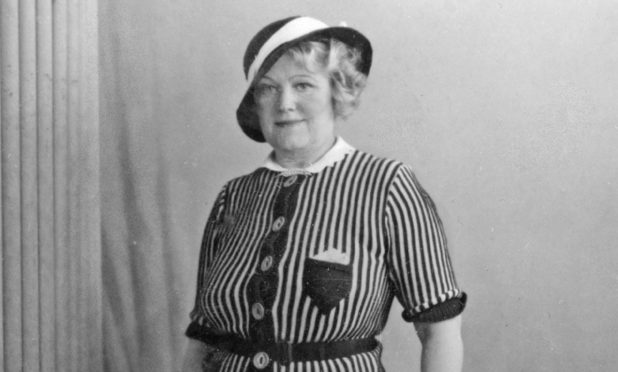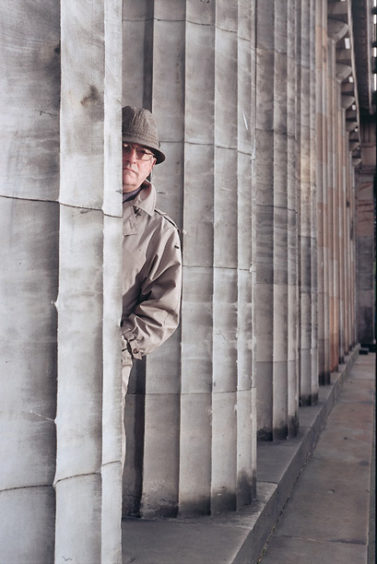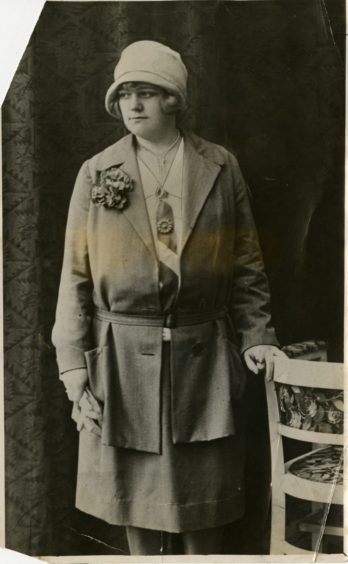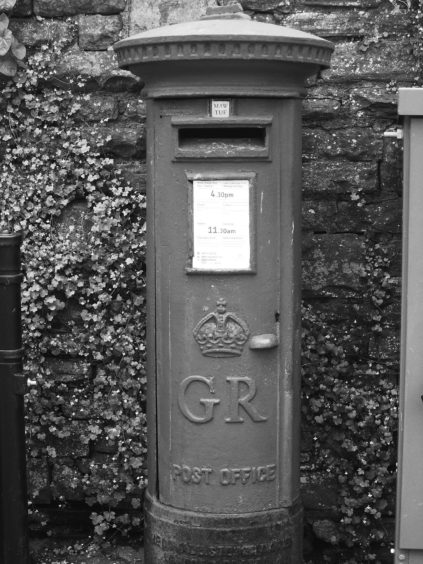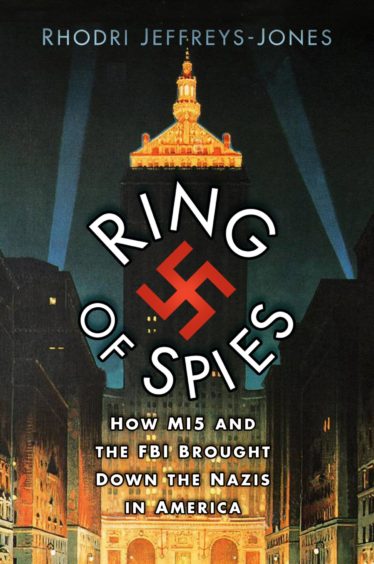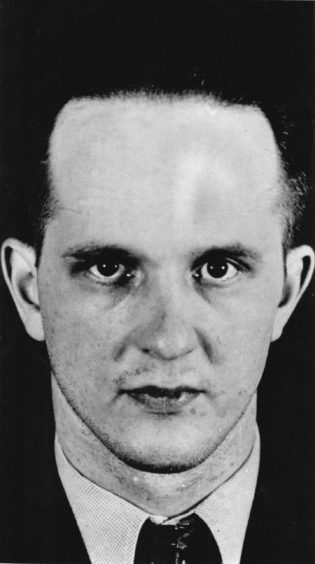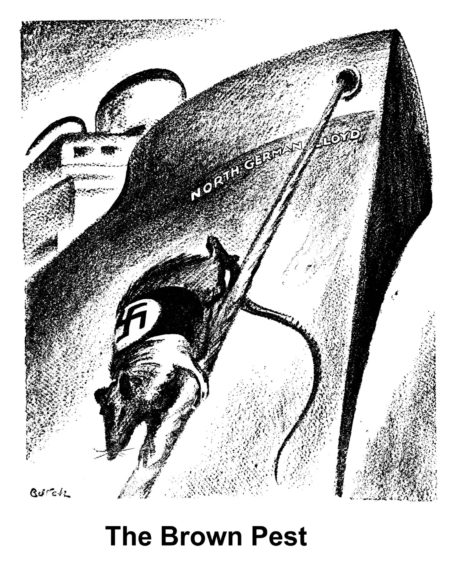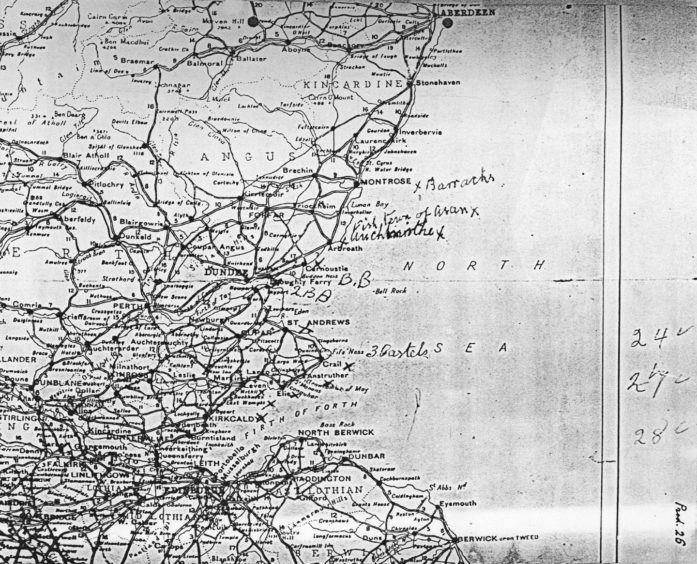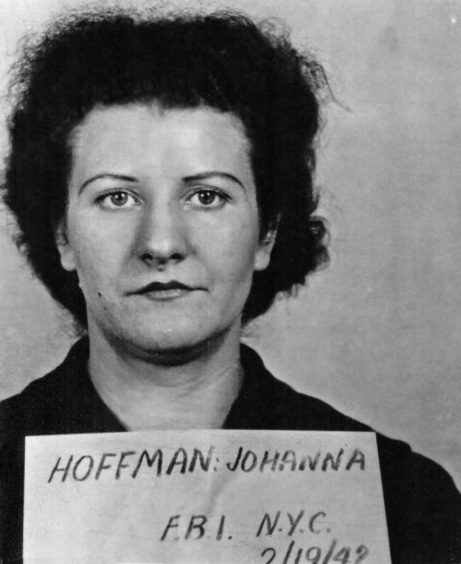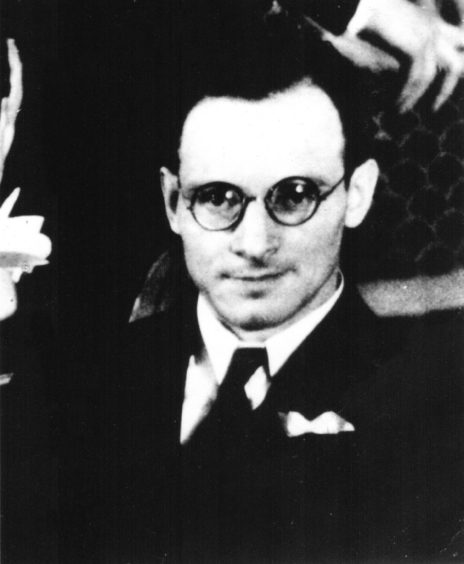She was the Dundee-based spy who gathered information for the Nazis in the build-up to the Second World War.
But, even as Jessie Jordan was committing treason to help the Germans, she became part of a massive MI5 and FBI investigation which eventually led to her imprisonment.
And, according to the author of a new book, who has trawled through more than 14,000 files from the period, the espionage activities of a massive network of traitors across Europe and in America ultimately led to the United States entering the conflict in 1941.
Rhodri Jeffreys-Jones, emeritus professor of history at Edinburgh University, has highlighted the crimes of people such as Mrs Jordan in his work Ring of Spies, which recounts how she was recruited by senior figures in Hamburg to gather information about important military installations and industrial factories across Scotland.
She arrived in Tayside after responding to a property advert in the Dundee Courier – and, in the next few months, moved into the dangerous world of collecting material, such as maps, charts and photographs, which she supplied to her paymasters.
However, the flood of foreign correspondence which was sent to 1 Kinloch Street eventually came to the attention of a suspicious postman and his bosses in Dundee.
Prof Jeffreys-Jones pointed out that Mrs Jordan was no femme fatale or Mata Hari figure.
On the contrary, although she was born in Glasgow in 1887, Jessie Haddow’s early days – after her father walked out on her – were spent working as a chambermaid in Dundee.
It was there that she met a German waiter, Karl Friedrich Jordan, and when he was forced to return home to do his military service, he called for his sweetheart to join him and the couple were married in 1912.
It was a short-lived union, with Karl dying in Hamburg from lung collapse in 1918, but his wife gained German citizenship and became a successful businesswoman, bolstered by the introduction of such devices as the hair drier and the rise of the cheap ‘perm’.
Mrs Jordan opened a shop in 1923, specialising in a setting known as the ‘Viennese wave’ and attracted many customers to her thriving premises in the city’s Hoheluftstrasse, especially from the Jewish sector of the city’s population, who flocked to the salon in such significant numbers that she was able to open a second shop.
She was at the high watermark of her life. But her fortunes were about to head north, then south and onwards on a path filled with secrets, lies and treachery.
As Prof Jeffreys-Jones said: “In spite of her success, Jessie Jordan was, by the 1930s, susceptible to intimidation.
“Quite apart from the vulnerability of her daughter, Marga, her son, Werner, was in military training in Germany and in a position to be victimised.
”These factors, as well as economic necessity by that stage, lay behind her decision to reconnect with her native Scotland. But she was intercepted on the way to the docks and, over the next few days, (Gestapo) officials persuaded her to spy for Germany’s foreign intelligence service, the Abwehr.
”These authorities offered a carrot as well as a stick – Jessie would be paid for her services. However, there was more than fear and finance behind her decision to spy.
“She had split loyalties, even fragmented identities, because of her background. And she loved the ‘Great Game’ of international espionage.
“She was a voracious reader of crime stories and spy thrillers. Explaining her actions later on, she wrote: ‘Excitement and change were life’s blood to me’.
“Those who commented on her appearance did not see the slouched form of a victim, but a woman of proud and charismatic deportment. She was an enthusiastic spy.”
And a far-travelled one. After arriving back in Scotland, she initially lived with her half-brother, William Haddow, in the Friarton district of Perth. But soon enough, she embarked on her mission, visiting Aldershot and chatting to soldiers in the local bars, where she made notes and drew sketches. As a hairdresser, she was a good listener.
Then she switched her attention to Talgarth, a village nestling in the eastern foothills of the Brecon Beacons in South Wales. She communicated her findings to the German authorities, but her exploits were already being scrutinised and she had to keep moving.
In June 1937, she spotted an opportunity to relocate to Dundee when she saw a notice in The Courier, offering for sale the ‘goodwill and contents’ of Jolly’s salon in Kinloch Street.
Jolly was an acronym for ‘Jesus Our Lord Loves us Yet’ and the seller was a religious-minded citizen, James Curran.
On September 7, Mrs Jordan purchased the going concern for £75, prior to spending a further £300 to refurbish it as a hairdressing enterprise. This was a significant amount of investment in such a modest business and when she was later questioned about the source of the money, she told the Dundee police it had come from “Mary Wallace”.
However, as Prof Jeffreys-Jones added: “In espionage terms, Mary was a fictitious cover. When MI5 obtained a letter purportedly written by Mary to her niece Jessie, offering financial support, its handwriting expert declared it to be a forgery.
“Perhaps guessing that she was being watched and needing an explanation for her expenditure, it quickly became clear that Jessie had written the letter herself.”
The net was closing in, but she was resilient. She acquired a flat with a view of the Tay estuary, and it was just a few hundred yards from her freshly-painted salon.
She joined a local library and displayed her penchant for lurid thrillers and noirish plots, borrowing the likes of E Phillips Oppenheim’s The Evil Shepherd, in which the lead character, Francis Ledsam, supped his liquid way through whisky, champagne and liqueurs inside the first 28 pages.
During the day, she continued the spying activities which she had started in England and Wales.
Travelling by bus, she made detailed sketches, took a large number of photographs and kept copious notes of the naval installations in and around the Firth of Forth and the port of Aberdeen and dispatched her reports to Hamburg.
Mrs Jordan was far from being a master criminal, but her efforts confirmed the existence of a plan to provide German bombers with useful coordinates.
And yet, even as MI5 delayed taking action, the authorities in Dundee weren’t inclined to dither.
Prof Jeffreys-Jones said: “One story which gained currency was that the local postman became suspicious of the volume of foreign mail that arrived at 1 Kinloch Street and told his superiors that Jessie might be dangerous.
”Whether or not because of the postie’s vigilance, from December 10 at the latest, Alexander Jack, an officer in the General Post Office in Dundee, operating under the authority of an HOW (Home Office Warrant), steamed open a number of envelopes bearing US stamps addressed to 1 Kinloch Street and photographed their contents.
”Mary Curran, who had worked for her brother-in-law at Jolly’s was another inconvenience. She and her husband maintained the appearance of friendship with Jessie, who spoke about politics with John, a tram conductor, and loaned him a book on ‘anti-Jewism in Germany’, together with a copy of one of Hitler’s speeches.
”But Mary’s superficial cordiality masked her suspicions and, on December 7, she spotted Jessie’s handbag resting on a table in the rear room of the salon premises and, being no devotee of privacy, opened the bag and discovered a map.
”Handwritten numbers on the map identified locations in Scotland and the north of England and Mary showed the map to the police who took photographs. Then she replaced it in the handbag.”
As a result of Curran’s intervention, the address in Kinloch Street was added to an ongoing mail watch and, soon afterwards, incriminating correspondence from the United States was discovered.
This, among other things, highlighted a plot to assassinate an American army colonel – and Mrs Jordan was arrested on March 2 1938.
City of Dundee Chief Constable, Joseph Neilans, had prepared the ground by obtaining search warrants for her premises in Kinloch Street, as well as for her half-brother, Frank Haddow’s house at 26 Strathmore Avenue in Coupar Angus.
On the morning of March 2, two police cars carried MI5’s Colonel Hinchley Cooke, Chief Constable Neilans, DI Thomas Nicholson and policewoman, Annie Ross, to the business address in Dundee. Their guide was Detective Lieutenant, John Carstairs, who had started a dossier on the Jordan case in November 1937.
The five-strong party entered the property, finding the accused, whom they detained, and 14-year-old Patricia Haddow, who worked in the shop.
They dug up the drains, raised the floorboards, and inspected Mrs Jordan’s former apartment at 23 Stirling Street. And eventually, they found a bag containing airmail letters in a cubicle-cum-bedroom, off the beauty salon, where it later emerged she was spending her nights.
Unsurprisingly, these developments sparked significant media interest. As Prof Jeffreys-Jones affirmed: “The next day, while crowds gaped at the suddenly infamous salon in Kinloch Street, Jessie made a one-minute appearance in court, during which time she was charged with offences under the Official Secrets Act.
”Facing blanket security, the Courier reporter had little to go on, so simply recorded that ‘she was attired in a smart black coat, with fur collar and a little green hat adorned with a feather’. A few days later, Jessie made a further four-minute court appearance in a sealed-off courtroom and was further indicted under a 1920 law for having failed to register with the Post Office as a forwarder of mail.”
During the trial, Mrs Jordan submitted an application to publish her memoirs. But this led to all manner of legal arguments between the authorities over such issues as freedom of speech and MI5’s desire to suppress the story.
She had pleaded guilty and was represented in court by the aspiring Conservative politician Arthur P Duffes KC, who issued an evocative plea in mitigation, which stated: “Having started as unwanted child 51 years ago, she finds herself once again an unwanted child as regards her native country and the country in which she had spent the greater part of her life.”
In another country at another time, she might have faced the death penalty. But nobody in authority was keen to pursue such a draconian policy.
Eventually, in May 1939, Mrs Jordan was found guilty of espionage and sentenced to four years imprisonment. At the outset, she was incarcerated at Saughton in Edinburgh, but the experience led to her falling seriously ill and requiring a sub-total hysterectomy.
Just a few months earlier, her daughter, Marga, had died as a result of what her husband, Tom Reid, called “an illegal operation”.
Yet if her crimes brought tragedy in their wake, Mrs Jordan was not inclined to slip into depression. When the Second World War began in the autumn of 1939, she was transferred to Aberdeen Prison, but her solicitor John R Bond – whose firm was based in Dundee – described her as “a model prisoner, who showed off her needlework to the other inmates and exhibited no interest in an appeal”.
He told the Courier that she was “not in the least depressed” and, as a consequence of her good behaviour, Mrs Jordan was granted early release in 1941 – only to be immediately arrested again and interned as an enemy alien for the remainder of the conflict before being deported back to Germany.
That might have been the end of the story with her death in 1954. But, as Prof Jeffreys-Jones spelled out, there have been recent revelations which emphasise the scale of the Nazi spy ring and the nefarious work they carried out in the years before the war.
He said: “Under Scots Law, a confidentiality clause had protected the Jordan files for 75 years, but they were now available.
“And these files revealed that MI5 intercepted a letter sent to Hamburg in January 1938, via Mrs Jessie Jordan in Dundee. It was from a German agent in New York, codenamed ‘Crown’, and revealed a plot to kidnap and inject, probably lethally, the US Army officer, Colonel Henry Eglin.
“The files showed that MI5 had tipped off the American authorities and, out of almost idle curiosity, I sent a freedom of information application to the FBI, asking for any documents pertaining to Jessie Jordan.
”It took him several years of digging, but John Russo at the Bureau did a great job. He produced no less than 14,500 documents with only very minor redactions.
”J Edgar Hoover, the director of the FBI from 1924 to 1972, was trained as a librarian in his first job at the Library of Congress. Whatever else you might think of him, he was a skilled administrator of information.
”His filing system placed the name of the first-identified person of interest at the head of every file. For this reason, and because of effective cross-referencing, Jessie Jordan’s name and that of Guenther Rumrich – whose alias was ‘Crown’ – appeared in the identification box at the head of all FBI reports on the great spy case of 1938.”
It might seem a very long way from a hairdressing salon in Jute City to the imposing offices of the Federal Bureau of Investigation in New York City, but Mrs Jordan was not alone among her compatriots in working to sell secrets to the Germans.
As Prof Jeffreys-Jones said: “Jessie was not the only Scottish traitor. There was, for example, Captain Archibald Henry Maude Ramsay, the anti-Semitic MP, who, like Jessie, spent the war behind bars for, in his case, conspiring to bring about a German invasion. Nor was Jessie the only spy to forward letters on behalf of the Abwehr.
“Mrs Gertrude Brandy performed the same function in Dublin until, again like Jessie, she fell victim to counter-intelligence surveillance.
”But she was unique in being a link, however accidental, in the chain of events which led to America’s entry into the Second World War on the side of the Allies.
”Unintentionally, her actions sparked the FBI enquiry into Nazi espionage in the US, leading to a sensational spy trial which changed opinion in America, which had previously been firmly wedded to the policy of neutrality.
”By early 1939, American opinion was firmly on the side of Britain and France and hostile to Germany.”
If there were any extenuating circumstances for Mrs Jordan and her behaviour, she always insisted, even in prison that, despite being born in Scotland, her loyalties were firmly with her adopted country.
She once told her daughter: “I am German, I love Germany, I would die for Germany and I would like to be buried in Germany.”
However, she was part of an orchestrated and extensive campaign of espionage, the sheer scale of which has been highlighted in Prof Jeffreys-Jones’ work.
As he said: “Hitler’s spies supported Franco in the Spanish Civil War and saturated Czechoslovakia to prepare for the Nazi invasion of March 1939.
”Perhaps most striking of all, though, was the earlier and widespread panic in the American and European media about the extent of German spying.
“Paris-soir reported in 1938 that Germany had 10 training schools for spies. In the same year, the Los Angeles Times claimed that Germany had 10,000 spies and the New York Times thought that Hitler was spending up to $80 million annually on spying. The neatly round figures are suspicious, but they do indicate a deep concern.
”What really shocked me was the pure evil of one of my book’s spies. This was Dr Ignatz Griebl, a veteran of the First World War who had a gynaecological practice in New York and who spied for Germany.
”He circulated and wrote anti-Semitic propaganda and sent to Berlin a blacklist of American Jews who would be ‘dealt with’ in due course, including New York’s mayor, the legendary Fiorello La Guardia.
“He devised a plan to set up a high-class brothel in Washington DC for the purpose of entrapment and, courtesy of the Gestapo and the Abwehr, he expropriated Jewish property in Bavaria and Austria for his own benefit – one of the affected Jewish families was then wiped out in the Holocaust.
”He also asset-stripped one of his mistresses and serially abused his wife.
”That is just a short list of his crimes. Nazi misdeeds never fail to shock.
”Nor should they.”
Ring of Spies: How MI5 and the FBI Brought Down the Nazis in America is published by The History Press.
